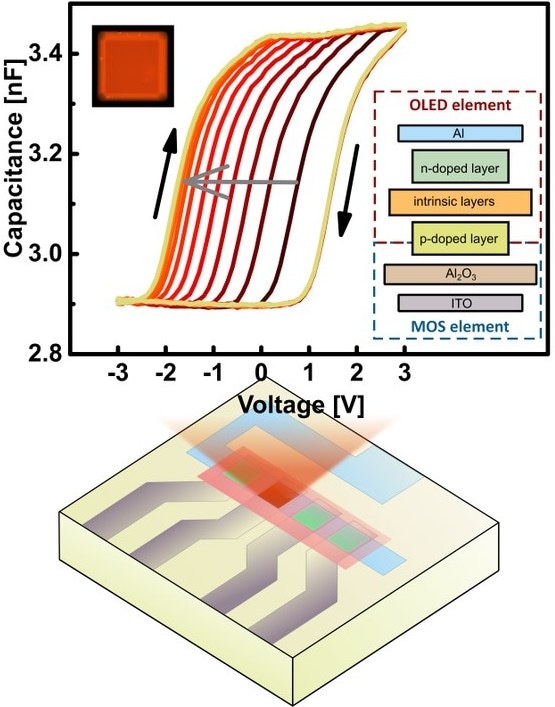Nov 26 2019
Researchers have developed a new storage technology that is based on a combination of an insulator and an organic light-emitting diode (OLED).
 The pinMOS memory—an organic semiconductor device resulting from the combination of an OLED and a capacitor. It has the characteristics of a Memcapacitor, interacts with light, and can be written and erased step by step. Image Credit: Yichu Zheng.
The pinMOS memory—an organic semiconductor device resulting from the combination of an OLED and a capacitor. It has the characteristics of a Memcapacitor, interacts with light, and can be written and erased step by step. Image Credit: Yichu Zheng.
This device was developed by a research team from the Center for Advancing Electronics Dresden (cfaed) at TU Dresden and the Dresden Integrated Center for Applied Physics and Photonic Materials (IAPP). With the help of this device, the stored data can be read both electrically and optically.
The data can also be added in portions, which means a number of storage states can be mapped in a single device. The study results were recently reported in Advanced Functional Materials, a prestigious journal.
Another innovation was associated with the measurements in the test series: The measurements were exclusively performed using the novel measuring software called “SweepMe!” An IAPP/cfaed start-up of the same name had developed this software.
The story started way back in 2015. Two cfaed researchers, both specialists in the area of organic electronics, were traveling together to attend a conference held in Brazil. The journey included a lengthy bus ride to the venue Porto de Galinhas, and that gave them sufficient time to engage in conversation.
It so happened that one of the two researchers—Professor Stefan Mannsfeld (Chair of Organic Devices, cfaed/IAPP)—discussed the concept with the other one—Dr Axel Fischer (Chair of Organic Semiconductors, IAPP)—that kept him engaged for a while already.
The combination of an insulator layer and a traditional OLED would be expected to lead to a storage unit because of the particular physical effects of the materials utilized. The storage unit can be read out or written on using both electrical and light signals—an inappropriate use of the OLED technology so to speak.
But the two eventually turned out to be an ideal match—Dr Fischer demonstrated that the IAPP already had the required experience and technologies, and therefore the analysis of this concept was just a matter of time. Yichu Zheng at Professor Mannsfeld’s chair proved an appropriate person to dedicate her doctoral dissertation to this subject.
Storing and Reading—with Light and Electricity
The study results are now available and have been reported in the Advanced Functional Materials journal. The researchers elucidate a novel type of programmable organic capacitive memory—a combination of a MOS capacitor (MOS = metal oxide semiconductor) and an OLED.
Known as “pinMOS,” the storage unit is a non-volatile memcapacitor that has high reproducibility and repeatability. The unique trait is that the pinMOS can store a number of states, as it is possible to add or remove charges in controllable amounts.
Another striking characteristic is that this basic diode-based memory can be both optically and electrically read from and written to. At present, a lifetime of over 104 read-write erase cycles has been accomplished, and it is also possible to maintain and differentiate the memory states over a period of 24 hours.
The outcomes demonstrated that the pinMOS memory principle as a dependable capacitive storage medium shows potential for upcoming applications in photonic and electronic circuits like visual storage systems or neuromorphic computers. Additionally, the co-authors from the Weierstraß Institute Berlin (WIAS) carried out drift-diffusion simulations that contributed to the exact understanding of the functional mechanism.
In 1952, Arthur W. Holt initially presented a diode-capacitor memory at an ACM conference held in Canada. But it is only now that this idea is being revived by using organic semiconductors, because all functions of a discrete connection of a capacitor and diodes can be incorporated into one memory cell.
Measuring with SweepMe!—Innovative Approach for the Laboratory
The latest laboratory measurement software “SweepMe!” was used to perform all the measurements in this research. This measurement software was developed by a start-up—a spin-off from TU Dresden. SweepMe! was founded by the physicists Axel Fischer and Felix Kaschura in 2018 at the IAPP. Both physicists earned their PhDs from TUD.
The study demonstrated the excellent versatility of the SweepMe! software. Be it the measurement of time-dependent and voltage-dependent capacitances, the processing of images from an industrial camera, the development of current-voltage properties, and the combination of oscilloscope and signal generator, all was implemented by simply using this single software.
Even advanced parameter differences, which would usually need a great deal of programming effort, can be applied in a very short period of time. Since October 2019, the SweepMe! software is available globally, free of charge.